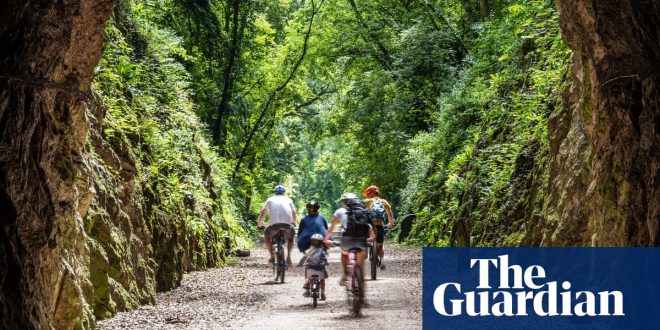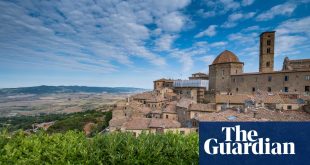It’s a noise the former railway tunnel probably hadn’t heard in a while. Somewhere in the dark is a hooting part-owl, part-forlorn steam train. My sister Ele has stopped on her bike to blow determinedly across her cupped hands like a flute. As she recreates this long-gone sound, I pedal on through the cool, damp air. Water drips steadily from the stalactite-coated brickwork as my front light illuminates pedestrians and their dogs looming from the echoing shadows.
We are cycling the Strawberry Line, a 10.75-mile, mostly off-road cycling and walking route from Yatton to Cheddar in north Somerset, on a sunny spring morning. White blackthorn flowers blossom in the hedges, and puddles splatter us with brick-coloured mud. I always love the thought that this rich red soil was formed when Britain basked close to the equator, before migrating north, along with Europe and North America.
The Strawberry Line was named after the fruit the former railway carried from this fertile red soil to London. It also forms part of National Cycle Network (NCN) route 26. The train line was decommissioned in the 1960s under Beeching’s axe. It was a blow for local transport, but it brought us many of today’s best-loved NCN routes. Complete with cuttings and tunnels, the Strawberry Line makes for a flat and direct, almost entirely traffic-free, ride.
Between Beeching’s axe and the founding of the NCN in the 1980s, some railway land was commandeered for other purposes, which means there are some on-road stretches and awkward road crossings on today’s cycling and walking routes. These are slowly being upgraded by Sustrans – the charitable custodian of the network – along with volunteers, the council and a pot pourri of others. The Department for Transport may fund improvements for an awkward main road crossing near Axbridge in 2025.
It is the dream of two NCN founders, John Grimshaw and Caroline Levett – along with their current organisation, Greenways and Cycleroutes – to insert the Strawberry Line into a 76-mile route circumnavigating the county, taking in the famous Bristol and Bath Railway Path, Two Tunnels Greenway and the River Avon Trail. The Somerset Circle is already two-thirds complete, with new segments recently opened around Shepton Mallet, and a new link connecting Westbury-sub-Mendip and Easton. I helped rebuild a couple of walls near Shepton as a volunteer during two of Greenways’ annual work camps. There are also spurs under construction to towns and cities along the way.
Before setting off from Yatton station, we discover a puncture in Ele’s rear tyre. Strawberry Line Cycle Project, which hires out bikes for all abilities from the station car park, lets us use its track pump after we replaced a failed patch on the inner tube.
From there, we cycle beneath an archway topped with a huge steel artwork depicting a steam engine plus walkers, cyclists and wildlife. A gritted track leads us to a narrower, mud-red path, past benches and information boards. The raised railway bed affords us glorious views across fields punctuated by rhynes – drainage ditches that help maintain low-lying pastureland – and of the spire of St Andrew’s church at Congresbury. We cycle through former stations at Congresbury and Winscombe, complete with platforms, and Sandford, where there’s a railway heritage centre.
The latest off-road section, completed in November, was purpose-built by National Grid beside a new electricity substation serving Hinkley Point. Crowds of newly planted saplings and tree whips, protected by plastic tubing, are arrayed beyond high fences. Already a steady stream of walkers and cyclists are enjoying the spring sunshine and the peaceful, traffic-free path. At one end, the substation hums gently.
The path climbs gently before Axbridge for impressive views across the Somerset Levels towards Brent Knoll and Glastonbury Tor. We eat toasted sandwiches at a cafe that doubles as an antiques and clothing shop. It’s one of at least four eateries and pubs with outdoor seating overlooking Axbridge’s handsome medieval town square and the impressive jettied 15th-century building housing King John’s Hunting Lodge museum.
after newsletter promotion
Cheddar Reservoir is vast and glittering in the early afternoon sun, set in a glowing green landscape, and Ele exclaims: “It feels like we’re on holiday.” The route wiggles between galvanised fencing behind a builders’ merchant and returns to the road in an industrial estate on the outskirts of Cheddar. One day, hopefully, dedicated cycling provision will extend into the town. This is where we turn around. While Strawberry Line volunteers have lovingly developed and maintained this route since the 1980s, a plaque says this section was built after a cycling schoolboy was killed by a driver in 1990 and his school campaigned for a safe cycle route. It’s a reminder that cycling and walking paths are more than simply leisure routes: they are essential transport infrastructure.
A future spur, the Pier to Pier Way, linking Clevedon’s Grade I-listed pier and Weston-super-Mare’s Grand Pier, is under construction. A key link over the Congresbury Yeo and Oldbridge rivers, the Tutshill Greenway, will open this spring. This and Clevedon sea defences paths offer year-round birdwatching spots, with redshanks overwintering at Tutshill and other rare birds passing through. Sadly, a vigorous campaign put paid to a separate two-way cycle route in Clevedon, claiming it would harm businesses and local drivers’ ability to park on the seafront.
North Somerset Council estimates the Pier to Pier will nonetheless generate 55,000 annual cycling and walking tourism and leisure-related journeys, with 15-20% of these between November and February, extending the tourism season and encouraging cycling visitors to spend more time in North Somerset. This will link with the Brean Down Way with its existing 100,000 annual users, looping south of Weston, via Brean Cross Sluices, back up to the National Trust headlands of Brean Down, via the natural pier at Sand Point. At the end, there’s an expansive view of the Bristol Channel, and a Victorian fort.
Thrillingly, for cycle commuting hopefuls and adventurers alike, these routes will also form the North Somerset Coastal Towns Cycle Route, running through urban centres all the way back to Bristol. The Owl in the Oak cafe and venue at Kingston Seymour, opened to serve the Weston-super-Mare to Clevedon cycle path, is hailed as evidence of the value of these extra visitors, and of potential future routes. With motor transport in North Somerset generating 43% of the area’s carbon emissions, these routes are also climate interventions.
The Strawberry Line is already a cycling and walking delight, with young bikepackers joining riders in their 50s (we greet the same couple three or four times on our day out) and countless dog walkers. Not only will the Somerset Circle provide a tourism boost for this beautiful rural county, but it will help people of all ages get about on foot and on wheels, under their own steam. With or without the sound effects.
This article was amended on 10 May 2024. The Strawberry Line was a Great Western Railway branch line, not on “the Somerset and Dorset line”, as a previous version said.
Laura Laker’s book, Potholes and Pavements: A Bumpy Ride on Britain’s National Cycle Network, is published by Bloomsbury (£16.99). To support the Guardian and Observer, order your copy at guardianbookshop.com. Delivery charges may apply
 Top Naija News – Nigeria News, Nigerian News & Top Stories Top Naija News – Nigerian Newspapers, Nigerian News. topnaijanews is a daily Nigerian newspaper covering Latest News, Breaking News, Entertainment, Sports, Lifestyle and Politics.
Top Naija News – Nigeria News, Nigerian News & Top Stories Top Naija News – Nigerian Newspapers, Nigerian News. topnaijanews is a daily Nigerian newspaper covering Latest News, Breaking News, Entertainment, Sports, Lifestyle and Politics.




